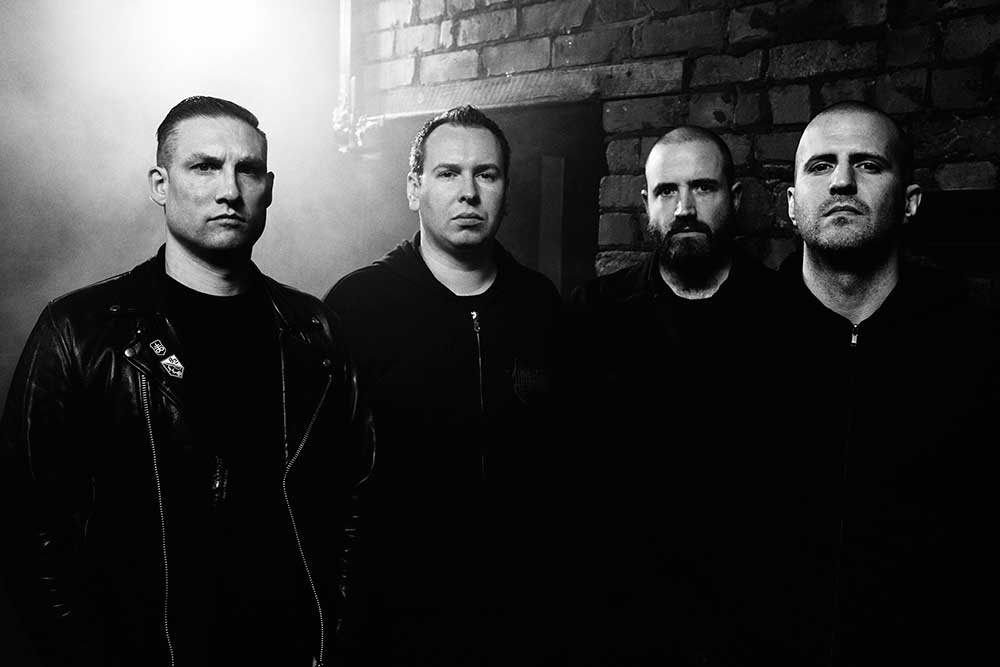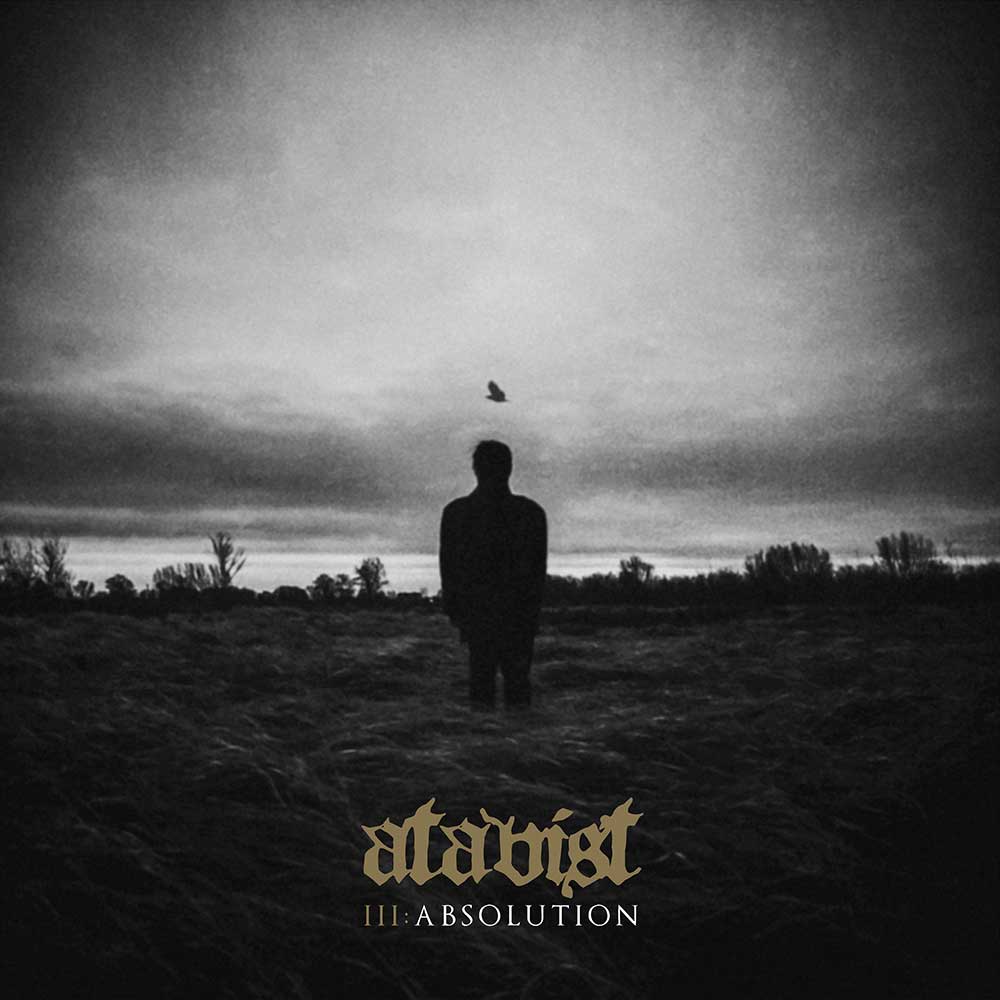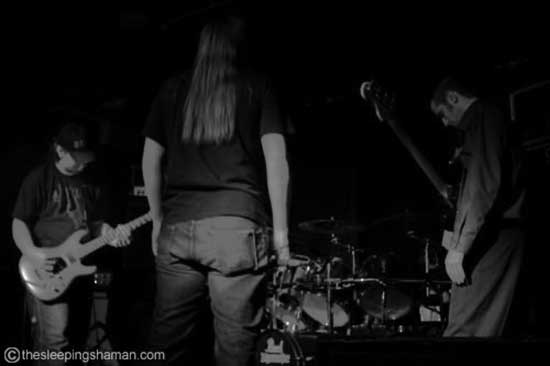Atavist
2021-03-03
by Niklas Göransson
From loss to absolution: British doom veterans Atavist have returned. Co-founder and guitarist Chris Naughton talks about finding uplift and emotional cleansing in the darkest depths of music.
– It’s been a strange creative process overall. I suppose that’s because, for the longest time, this album was a bit of an intangible thing to me. I’d occasionally come up with riffs whilst playing guitar or writing for other projects, put those ideas down in demo-form and think, ‘I really should do something with this at some stage’. But then never got around to it. It wasn’t until 2017 or so that those songs began to be realised, when I re-aligned with the other guys – Shane, the bassist, in particular – and we began setting aside some time each week to make more considered, whole tracks out of the existing material. Once we got going and started coming up with fresh ideas, everything soon came together.
Their third album, “III: Absolution”, was released by Candlelight and Spinefarm Records in June 2020 – thirteen years after its predecessor, “II: Ruined”.
– The first song, “Loss”, was in an almost finished state for about a decade, but the remaining tracks were disparate ideas that needed shaping into something solid. I think “Struggle” was the hardest song to finish as it pushed the ATAVIST sound into new areas, making for a really harrowing experience. So, we really didn’t want to get that one wrong. “Self-Realisation” was intentionally a more direct and straightforward affair – meant to resemble a CORRUPTED seven-inch style song, like the ones we loved in the 90s and 00s. They used to do these higher-energy deviations from the more languid, crushing stuff on the full-lengths and put them out on splits and EPs. This was back in the days when seven-inch vinyl only cost a few pounds. Shane in particular was a big collector of these releases and we always loved that aesthetic.
CORRUPTED is a doom/sludge band from Japan, active since 1994. Despite being a relatively prominent act in the genre, they’ve always been extremely media-shy and have granted no interviews or even taken any promo photos. The only images that exist were taken by fans at live shows.
– The closing track, “Absolution”, was meant to be a peak on the album, so I really wanted it to have a build-up ending with a climactic payoff. As with much of my writing, I like the idea of concepts and approaching the design of an album as a sonic landscape. Monotonous musical progression doesn’t always put across ideas very well in my opinion, so I want things to ebb and flow. The aim being to retain the atmosphere and drama of the tales you’re telling, or the point you’re putting across. For me, I really think we managed it on that track. I also love the addition of strings and synth within it as well. All of which brings a welcome change to the song-writing dynamic. They aren’t the kinds of sounds we ever explored as a band before, probably because we didn’t know how to do it in our youth but also due to us not having made the connections we have over the years. Like Jo Quail and Bianca Blezard, who played cello and violin on the album. In fact, I think the violin part at the end of “Loss” is one of my favourite-ever moments in doom metal, full stop.
The album was recorded at Chester’s Skyhammer Studios as well as Foel Studio in Wales – all under the watchful eye of veteran British producer Chris Fielding, known for his work with bands like ELECTRIC WIZARD, NAPALM DEATH, and PRIMORDIAL.
– Chris is a close friend of ours; he was in AGENT OF THE MORAI, a band we often played with during the first ATAVIST era. So, he really has been around since the beginning. It was nice sharing demos to get his thoughts on the material, and – seeing as how he’s watched the band develop over the years – for the project to come full circle by recording with him. For me, Chris is ‘the man’ for production in general, but black and doom metal in particular. He knows the genres, he knows the music, and just ‘gets it’ without needing to be told. For me, that is invaluable when it comes to having such a monster of a record properly realised.

Most of “III: Absolution” was conceived through a diligent pre-production process. The material underwent multiple demo phases, with painstaking attention paid to every step of the way. “II: Ruined”, on the other hand, was recorded live in the studio with riff changes decided on the fly and communicated by a nod.
– When we made the ATAVIST albums of the early 2000s, we were in a much more ‘analogue age’ as far as music production goes. Except for our singer, Toby, we had no idea about click tracks, recording software, home demos, and so on. We did it the only way we knew how: we wrote the songs together in a rehearsal room and played them until they were tight enough to record. “II: Ruined” was a by-product of that era and mentality. So, while I think it still has a purity and a strength to it because of that – we’ve obviously grown, learned, and developed over the years alongside emerging technology. Upon reflection, I think I had always wanted ATAVIST to be a bit more clinical and considered than we used to be. In the early days, it was all about tone and presence and sonic power. While we didn’t skimp on memorable riffs or anything, I always had grander visions of it being a little more punchy and defined.
How much do you think time has time affected the ATAVIST sound?
– I’m not sure it necessarily has. I guess I’d prefer to see it as a refinement – or at least an aesthetic and stylistic growth. It’s still the same four guys as the previous album, but with an additional thirteen years of life experience surrounding them. It’s funny, we had this discussion about the human body and how, apart from a few key braincells, all cells regenerate every eight or so years. This means that ‘technically’ none of us made or played on the early releases and that this was almost like a new era, both physically and aesthetically. No one was expecting a record from us, so we could take our time and make it all the more special. While it still retained elements of both the playing and writing style we had on our earlier works, it was somehow just more and I’m glad of that.
Chris set out to create music that would sit more closely with ESOTERIC, COLOSSEUM, or EVOKEN rather than the sludgier side of things, with which ATAVIST used to be considered.
– Moving into “III: Absolution”, we were clear that we should make sure the music was thoroughly scrutinised and worked out in pre-production, rather than on the fly in the studio. Given that there are seventeen-minute songs on the album, and saying this sounds almost like an oxymoron… I feel there’s no fat on the songs because of it. In an ATAVIST context, I’d say things need the opportunity to breathe, lock in, and create a weird perception of time for the listener – to almost make that expanse of existence seem confusingly shorter because of how the music is written. I believe that latter point is only understandable if you’ve ever fully given yourself over to an album like this and immersed yourself in it.
“III: Absolution” did indeed take quite a while to process, especially for someone who rarely listens to this type of patience-rewarding metal. In the age of short attention spans, it can pose a refreshing challenge.
– I know, even during its composition process, that many people will find this music hard to penetrate; it’s a niche style of metal to some extent. But I have always found great uplift and emotional cleansing from sitting in the wake of such epic tracks from other bands, and I really wanted to capture that here. Listeners who are used to three-and-a-half-minute metal ‘hits’ are likely to feel as if someone has slowed the world on its axis. But, equally, if you have the will to tune into this music, it will ultimately pay off. The point is that the layering, the building up, the sorrow, the grief, the longing, the balance, and then the final climax are all amazing tools to take you on an emotional journey you probably didn’t even know you wanted to embark on. Hence why I find this kind of music to be like no other: give yourself fully over and it has a power that’s goosebump-inducing. I remember listening to songs like “Dilapidation and Death” by COLOSSEUM or “The Blood of the Eyes” by ESOTERIC and being transported to another realm. The last five or six minutes of the former are up there with some of the most important moments in death/doom and funeral metal. Try not to feel something special listening to that in the right frame of mind. It’s electric. It’s one of those situations where, ‘if you know, you know’. You implicitly understand that feeling we’re all chasing, and the strange uplift to be found in the darkness and depths of it all. I highly recommend others to follow us down the rabbit hole.

ATAVIST came into existence around 2004, after Chris met bass player Shane Ryan through a mutual friend in Manchester. They started hanging out, listening to music, and then writing together.
– When we first started out as a band, if you can call two guys a band, we were still in the pre-social media era. We spent a lot of time on forums – if you remember those – like Southern Lord and Doom-metal.com. Through connections we made with like-minded people on there we chanced across Jamie Sykes, the original drummer of THORR’S HAMMER and BURNING WITCH. It turned out he’s not actually American like the remaining guys in those bands; he was currently residing on the other side of the hills from us, about forty minutes away in a place called Wakefield.
THORR’S HAMMER was an American doom/death band from Seattle, Washington, fronted by Norwegian vocalist Runhild Gammelsæter and featuring also SUNN O)))’s Stephen O’Malley and Greg Anderson. BURNING WITCH was the latter two’s continuation of THORR’S HAMMER, notable for their collaboration with renowned producer Steve Albini.
– We’d already written the basis for what was our first track, “31:38”, named after its length, and started talking to Jamie about him joining the band. We went over to a place near where he lived to rehearse for the first time, in a now-legendary shithole practice studio called Audiozone. It was primitive and cold and probably exactly what a band like ours needed to begin with. After one or two sessions with Jamie, he pretty much had the entire thirty-minute song down and so we started writing two more: “20:11” and “14:12”. It was at that point we needed a vocalist, so we put out some feelers and Toby responded. He lived a little further away at first so when we eventually managed to get him down to the studio to try out, he really unleashed the beast and powered forth the vocals – blowing out all the blood vessels in and around his eyes in the process. As a result, we knew he was the right man for the job! And so began the long journey that’s now led us here…
ATAVIST kept up a formidable pace during the first three years, putting out two full-length albums and a variety of other releases. However, in 2008 – just as they’d gained significant momentum – all activities ceased.
– We went through quite a few line-up changes over the years. I guess it became a bit chaotic. After the first album, Jamie moved to America to get married so Callum joined on drums for “II: Ruined” and the subsequent EP. Callum then moved away for a few years to go study in London, so Simon, the WINTERFYLLETH drummer, took his place. Then Toby and Shane left after a spat of youthful differences we were unable to resolve. To cut a long story short: a few toxic relationships got in the way of the band and affected how we were with each other. That caused divisions and ill feelings between us and became the beginning of the end for the first era. We were in our early twenties and not really geared up with enough confidence or life experience to navigate or deal with such things. Ultimately, we were just young and lacked the emotional tools to deal with our interpersonal issues. Our older selves would simply have shut those things down and cleared house, but that’s easy to say with experience. So, by the time we got to 2008 I was the only original member left, and I guess it wasn’t really ATAVIST in the truest sense. By then, Simon and I were more interested in doing WINTERFYLLETH anyway, so we forged on with that and the other guys got involved in a number of projects also.

What would you say are the main differences between WINTERFYLLETH and ATAVIST?
– Other than the fact that one is black metal and the other is death/doom, I’ve always seen them as conceptually separate entities that are joined at some levels. WINTERFYLLETH tries to have a ‘helicopter view’ of society and serve as social critique through the lens of ancient poetry and prose related to the modern world, whereas ATAVIST has been more about the individual in that world. In ATAVIST, we explore the state of things by looking inwards at the depths of the human condition in all its guises. Be that through the struggles, introversions, emotions, or peaks and troughs of the individual as part of society, or how we ourselves relate to the imploding catastrophe that is the world over the years. In some ways, the bands are almost like opposite sides of a coin: they reflect us as individuals and provide contrasting perspectives on society and life.
After seeing one another on several occasions, at shows and so on, Chris, Toby, and Shane started talking again. They realised they’d lost a lot of valuable time and history and so decided to leave it all behind and move forward.
– Putting the band on hold for over ten years had plenty of upsides. We drifted away from each other and went off to do our own things, which gave us distance from our issues and a chance to reflect on and realise that ATAVIST is – and probably always should’ve been – more than our personal differences. All of that was eventually resolved and washed away when we made “III: Absolution”. One could perhaps say that it became about absolving our differences to some extent. While the album isn’t directly a reflection of our broken friendships, it is obviously a means by which we found absolution with each other. So, ultimately, the story arc of the song titles becomes a reflection of our own lives, as well as a look inwards on the human condition.
“III: Absolution” is divided into four chapters and, to a certain extent, progresses onwards from the general themes of “II: Ruined”.
– On “II: Ruined”, the concepts were not always immediately apparent, due to the lack of lyrical visibility we gave them in the booklet. But equally, given the artwork and aesthetic of the record, its not a huge leap to realise that they describe how everything is broken, decrepit, crumbling and lost… all the while searching for a sense of hope in a dark place. Again, ATAVIST has generally been about ‘the individual’ in one way or another – be that from a nihilistic perspective or from, say, one of personal struggle or introspection. The music and messages have always been very inward-looking, almost like putting a mirror up in front of the problems and turmoils of the self within an imperfect society. With “III: Absolution”, that is no different and the narrative plays out through the titles of the tracks and feelings of the music. “Loss” is the act of losing something important or valued. “Struggle” is the hard time you face in coming to terms with said loss. “Self-Realisation” is a rumination on the balance you find when you start managing grief, and “Absolution” is the relief you find at the end of an arduous voyage. This album was meant to be about finding the start of rebalance, but not necessarily complete inner peace. It’s the large sigh at the end of personal strife and the alleviation of having reached some semblance of a plateau following a fall. Those things considered, I hope people sense all this in the music and can relate to it when considering the trajectory of their own lives and experiences.



